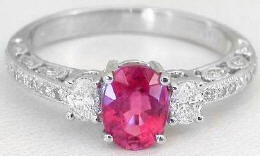
A Blue Zircon and Diamond Gemstone Engagement Ring. Blue Zircon is the birstone for December. Since zircon has a high refractive index, its sparkle is similar to that of a fine diamond.
Tip #1-Think outside the box. You already are, in fact, if you’re considering a gemstone engagement ring. Diamonds are beautiful and rare, but it’s so much more eye-catching and unique to wear a gemstone engagement ring. There are many approaches that you can use to select the perfect gemstone. You could choose her birthstone or your birthstone. Or you could find a gemstone engagement ring that incorporates both birthstones. At MyJewelrySource, we make most of our jewelry in house so if you would like to incorporate two gemstones in one of the rings you see on our website, we can definitely do that for you. How about a blue or green gemstone that matches her beautiful eye color. You can also choose the gemstone of the month you’re getting married or even of the month you first met. Or simply choose her favorite color! Gemstones are available in just about every color so you will have a lot of engagement ring options no matter what choice you make.




